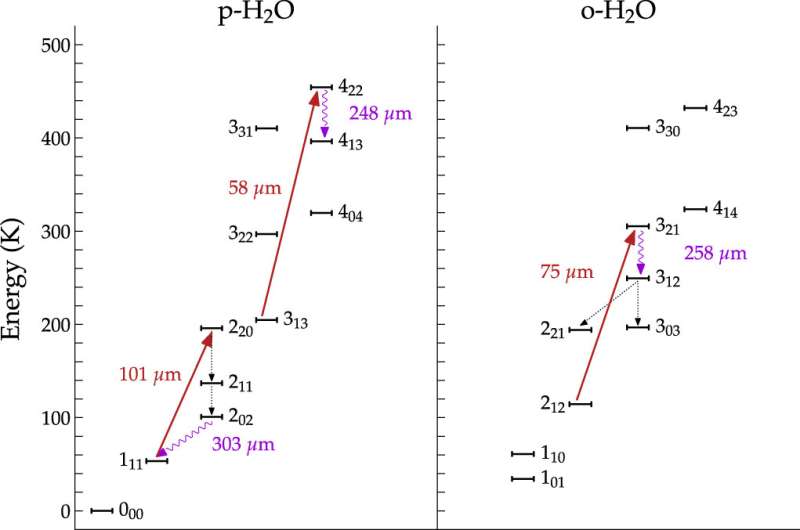This article has been reviewed according to Science X's editorial process and policies. Editors have highlighted the following attributes while ensuring the content's credibility:
fact-checked
peer-reviewed publication
trusted source
proofread
Galaxy J1135 reveals its water map

Water is essential for life, but for astrophysicists, it represents something more. Researchers look at water in galaxies, its distribution and in particular its changes of state from ice to vapor, as important markers indicating areas of increased energy, in which black holes and stars are formed. In essence, where there is water vapor, something important is going on.
A new SISSA study has now revealed the distribution of water within the J1135 galaxy, which is 12 billion light years away and formed when the universe was a "teenager," 1.8 billion years after the Big Bang (already the subject of a previous SISSA study).
This water map, with unprecedented resolution, is the first ever to be obtained for such a remote galaxy and is the main topic of a study recently published in The Astrophysical Journal. The authors of the study explain that the map can help us to understand the physical processes taking place within J1135 and shed light on the dynamics, still partially unclear, surrounding the formation of stars, black holes and galaxies themselves.
Studying galaxies: Why water is so important
"Water can be found not only on Earth but anywhere in space, in different states. For example, in the form of ice, water can be found in so-called molecular clouds, dense regions of dust and gas in which stars are born," explains Francesca Perrotta, lead author of the study conducted by the Galaxy Observational and Theoretical Astrophysics (GOThA) team at SISSA.
"Water acts like a cloak, covering the surface of interstellar dust grains, which form the building blocks of these molecular clouds and the principal catalysts of molecule formation in space."
Dr. Perrotta continues, "At times, something breaks the stillness and coldness of these molecular clouds: the birth of a star, which releases heat, or a black hole which begins to aggregate matter, emitting energy. Radiation from stars and other sources can heat the icy water, sublimating it into the gaseous phase."
"As the water vapor cools, it emits light in the infrared part of the spectrum. Astrophysicists can then observe this water vapor emission to map the regions of the galaxy where energy is produced, giving us unprecedented insights into how galaxies are formed." This information can then be combined with mappings of other molecules such as carbon monoxide (CO), which are also used in the study of these phenomena.
Gravitational lensing: How scientists studied J1135
How is it possible to study a galaxy in such a young and distant universe? The answer is gravitational lensing, a technique that enables the observation of remote celestial bodies thanks to spatial objects of large mass which are closer to Earth.
According to the principles of general relativity, these foreground bodies distort the light from sources which are positioned behind the same objects but are perfectly aligned with them, almost like a giant cosmic lens that allows us to locate and study galaxies, even the most remote ones. Lensing was a key factor in another recent study by SISSA dedicated to the discovery of J1135.
How galaxies are formed: There's still much to discover
Dr. Perrotta explains that this study is valuable partly because it also extends our knowledge in an important area: "It isn't yet clear how galaxies are formed. There are at least two possible scenarios, not necessarily alternative: one sees the aggregation of small galaxies to create larger ones and the other sees the formation of stars in situ. Studies like ours help us to understand what is happening, specifically in that galaxy, but we can also potentially deduce more generic information from that."
Future observations, similar to those already performed by the James Webb Space Telescope, the largest telescope ever sent into space, could reveal further information about J1135 and lead to a more accurate mapping of its molecules.
Prof. Andrea Lapi from the Astrophysics and Cosmology Group at SISSA, coauthor of the study and co-PI of the GOThA, comments, "The remarkable achievements obtained in this work have been possible thanks to a collaborative effort of a few senior researchers and a multitude of talented young scientists (Ph.D. students and postdocs) mastering different expertises, from analysis of observational data to numerical and data science techniques, to theoretical modeling and interpretation."
"I would like to stress the capability of our team members to rapidly acquire a robust background, redirect their actions, and produce cutting-edge original results in novel and unexplored research fields, like astrochemistry at high-redshift in the present case. This is the way research in (astro)physics should proceed."
More information: Francesca Perrotta et al, The Way of Water: ALMA Resolves H2O Emission Lines in a Strongly Lensed Dusty Star-forming Galaxy at z ∼ 3.1, The Astrophysical Journal (2023). DOI: 10.3847/1538-4357/accd72
Journal information: Astrophysical Journal
Provided by International School of Advanced Studies (SISSA)





















